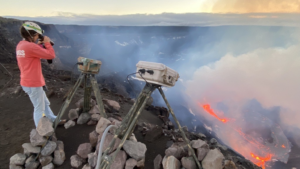The USGS Hawaiian Volcano Observatory says that following the Sunday night, Dec. 20, eruption at the Halema’uma’u Crater of Kīlauea Volcano, the lava lake has been rising approximately several meters (yards) an hour since the eruption began. The current lava lake exhibits a circulating perimeter, but stagnant center.
The event has been accompanied by moderate amounts of deformation, indicating deflation of a magma reservoir under Halema’umau. Rates of tilting have decreased slightly since the beginning of the eruption.
Increased rates of seismicity in the summit region continue. Sunday early evening, there were a number of 3.0 to 3.5 magnitude earthquakes in the area. The eruption began at 9:30, with some fountaining inside the Crater, up to 82 feet high. A magnitude-4.4 earthquake located beneath Kīlauea Volcano’s south flank occurred on Sunday at 10:36 p.m. HST.
Visitors to the Hawai’i Volcanoes National Park should note that under southerly (non-trade) wind conditions, rockfalls and explosions can result in a dusting of powdery to gritty ash composed of volcanic glass and rock fragments. These ashfalls represent a minor hazard, but visitors should be aware that dustings of ash at areas around the Kīlauea summit are possible.
HVO has decreased Kīlauea’s volcano alert level to WATCH and its aviation color code to ORANGE, reflecting the less-hazardous nature of the ongoing eruption. Sunday night, the aviation color code was RED, and the alert level at WARNING, indicating an imminent or ongoing eruption.
The last major eruption of Kīlauea was from early May into August, 2018, when lava erupted from the East Rift Zone and destroyed more than 600 homes plus roads, and covered much of the Lower East Rift Zone. In mid 2019, the water lake in the crater appeared and kept growing. Sunday night’s lava incursion evaporated the water lake to steam.
Photos courtesy USGS Hawaiian Volcano Observatory


